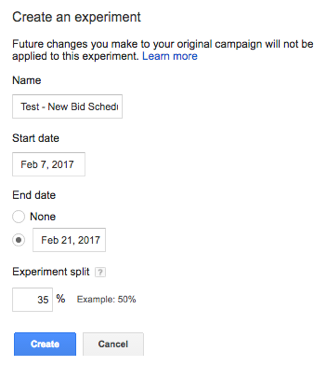Google is constantly evolving. One of its major focus points is offering flexibility towards advertisers so they can test, optimise and iterate. With this in mind Google has launched two new powerful tools called “drafts” and “experiments”. Since February 1, 2017 these new tools have fully replaced the AdWords Campaign Experiments (ACE) tool. In order to better spell out the benefits of the “drafts” and “experiments” tools, I will first explain how the ACE tool works before describing the new tools. The ACE tool allowed advertisers to test changes at ad group level. One important remark before moving forward: note that ACE was not available at campaign level.
How to create an experiment with the ACE tool?
- The advertiser had to define the start - and end dates of the experiment and the split of budget between the control ad group and the experimental ad group.
- The advertiser had to pause the original ad group in which you wanted to conduct tests. After that, he had to create two copies of this ad group (the experimental ad group and the control ad group).
The aim of this was to avoid using the historical data of the original ad group which could have led to an advantage to one of the experiment groups. Indeed, if the historical data would have been kept for the original ad group, its quality score would have been higher than the quality score of the experimental group.
- The advertiser had to determine all the factors that would be the subject of the experiment.
When adding new keywords, ads or ad groups to your experiment, he had to select “Add as experiment only keywords”. Note that the advertiser also had to be accurate in the changes he made. One clear example is the following: if he marked an ad as “experiment only” in a “control only” ad group, that ad group would receive no impression.
Once he had defined all the settings and changes, the test started to run for the selected timespan and the advertiser was forced to leave the ad groups untouched. Using the ACE tool is work intensive and prone to error.
Now we are entering the heart of the matter. As you will see during the following paragraphs, there are many improvements and changes in the “drafts” and “experiments” tools. The first one is that you can test at the campaign level.
But how can we create a draft and an experiment?
1. Select the campaign in which you want to make changes
2. Click on “Drafts” (at the top right in the AdWords interface)
You have created an exact copy of the campaign including the historical data. In that case, you benefit from the historical data without biasing the result upfront. The only difference between the original campaign and the draft here is the name, which needs to be different of course.

3. Make all the desired changes in the draft
Knowing that all changes made in the original campaign are also made in the draft campaign and that all changes made in the draft campaign are not applied in the original campaign, you don’t have to specify what you are testing compared to the ACE tool. This accounts for a more natural setup flow.
4. Select “Run an experiment”
When you are ready setting up all the required changes, you can choose to either update the original campaign or make an experiment. You will choose to update the original campaign when your goal is to make a lot of changes before putting it live. Otherwise, creating an experiment is more recommended to your goal.
5. Fill in the form
As indicated in the screenshot below the first step is to give a name, a start and an end date (AdWords recommends a minimum time duration of 30 days) and the split of budget (which can be more accurate than with the ACE) to your experiment.

Since the experiment has been created, you are allowed to make changes in the original campaign, in the draft campaign and in the experimental campaign. But all the changes in the original campaign won’t be applied in the experimental campaign. These changes will only be applied to the fictive campaigns (drafts).
In sum, the ACE tool was difficult to use because the advertiser had to define a lot of individual elements, was able to make mistakes and then leave it untouched post go-live. In the “drafts” and “experiments” tools, it is more peaceful to define and test some experiments. The new tools provided by Google are more user friendly and reduce the risk of introducing errors In the long-term, the benefits may be huge and advertisers may derive great knowledge from them. Once an experiment has been conducted, advertisers can implement the learnings. More important, those tools stimulate iteration and improvement and that’s what it’s all about in performance marketing.
AUTHOR
| LinkedinThis email address is being protected from spambots. You need JavaScript enabled to view it.
Tags:


